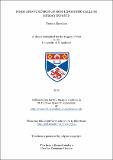Files in this item
Form and function of non-linguistic calls in human infants
Item metadata
| dc.contributor.advisor | Gomez, Juan-Carlos | |
| dc.contributor.advisor | Zuberbühler, Klaus | |
| dc.contributor.author | Kersken, Verena | |
| dc.coverage.spatial | 218 | en_US |
| dc.date.accessioned | 2012-09-24T08:31:06Z | |
| dc.date.available | 2012-09-24T08:31:06Z | |
| dc.date.issued | 2012-06-19 | |
| dc.identifier | uk.bl.ethos.556412 | |
| dc.identifier.uri | https://hdl.handle.net/10023/3149 | |
| dc.description.abstract | Before infants speak their first word, they already produce a large variety of sounds. Whilst the developmental process that leads to speech production is very well documented, little attention is given to how non-linguistic sounds function in the child’s everyday environment and whether they show acoustic consistencies similar to those found in the calls of non-human primates. This thesis investigated whether human infants between 11 and 18 months have “calls”. The first study observed 22 infants in their everyday nursery environment in Scotland and identified a number of contexts in which infants produced vocal behaviour. Vocalisations in five of these contexts, giving, declarative pointing, food requests, protests and action requests, were then subjected to an acoustic analysis. Results of the discriminant analysis suggest that four categories of vocal behaviour can be distinguished on the basis of their acoustic properties alone. To investigate whether these calls are part of a universal human repertoire, we conducted a cross-cultural comparison of the acoustic properties of vocal behaviour showed that, despite a slightly higher level of variation; four categories of calls could still be discriminated above chance level. This suggests that human infants possess calls with rather fixed acoustic properties as part of their vocal repertoire in addition to other, more flexible vocal behaviours. In order to assess whether listeners can gain information from these calls, we conducted a playback study with parents, experienced and inexperienced participants. Results show that all participants can categorise all vocalisations above chance level. Parents were the only participants that showed significantly better scores in correctly classifying vocalisations recorded in Scotland over those recorded in Uganda. Overall, the studies demonstrated that infants, as part of their vocal repertoire, produce some classes of calls that have constant acoustic properties across infants from different cultures, and contain information about the infant’s activities that can be picked up by a listener. | en_US |
| dc.language.iso | en | en_US |
| dc.publisher | University of St Andrews | |
| dc.rights | Creative Commons Attribution-NonCommercial-NoDerivs 3.0 Unported | |
| dc.rights.uri | http://creativecommons.org/licenses/by-nc-nd/3.0/ | |
| dc.subject | Developmental psychology | en_US |
| dc.subject | Communication | en_US |
| dc.subject | Evolution of communication | en_US |
| dc.subject.lcc | BF723.C57K4 | |
| dc.subject.lcsh | Developmental psychology | en_US |
| dc.subject.lcsh | Infant psychology | en_US |
| dc.subject.lcsh | Interpersonal communication in infants | en_US |
| dc.subject.lcsh | Nonverbal communication in infants | en_US |
| dc.title | Form and function of non-linguistic calls in human infants | en_US |
| dc.type | Thesis | en_US |
| dc.contributor.sponsor | Leverhulme Trust | en_US |
| dc.type.qualificationlevel | Doctoral | en_US |
| dc.type.qualificationname | PhD Doctor of Philosophy | en_US |
| dc.publisher.institution | The University of St Andrews | en_US |
This item appears in the following Collection(s)
Except where otherwise noted within the work, this item's licence for re-use is described as Creative Commons Attribution-NonCommercial-NoDerivs 3.0 Unported
Items in the St Andrews Research Repository are protected by copyright, with all rights reserved, unless otherwise indicated.


